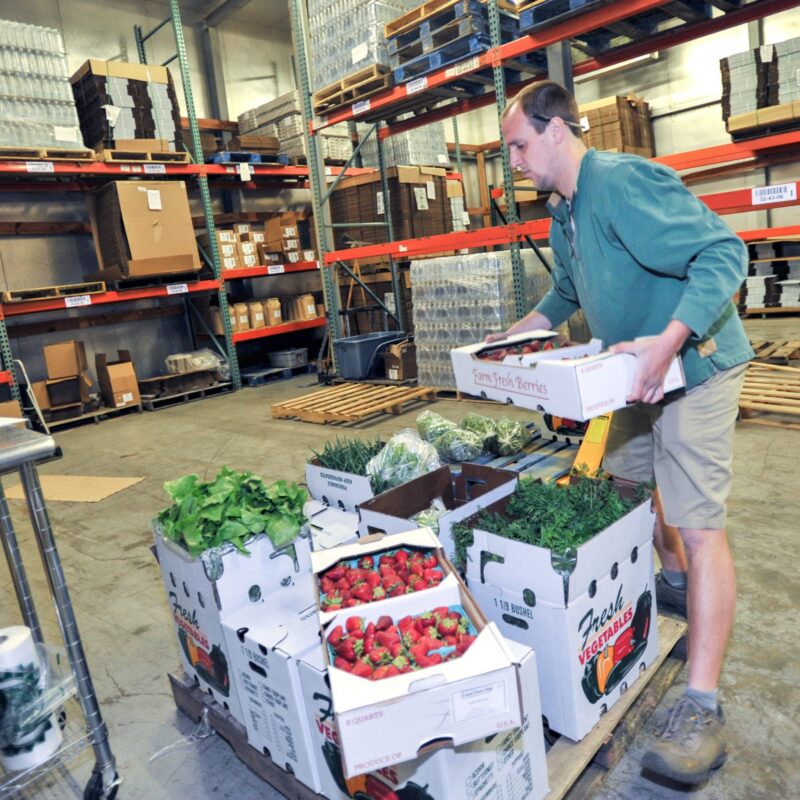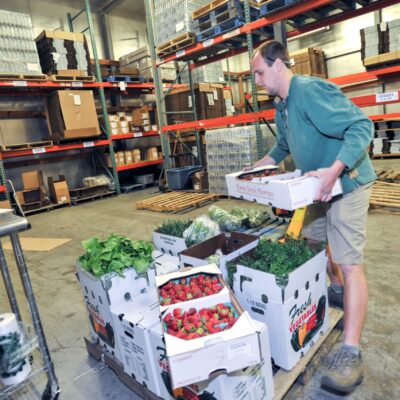At the intersection of Fifth and Market streets, one of my bike mentors, Paul Buschi, noticed my slightly terrified expression. “You O.K.?” he asked. I smiled and relaxed. “See,” he said, “it’s not hard to go from one place to another on your bike.”
What Buschi wants me and others to know is that bike commuting doesn’t have to be a burden, but a pleasant experience for the body and mind. He’s part of the Bike Mentor Program, sponsored by Blue Wheel Bicycles and Performance Bicycle Shop, which began when Shawn Strubbe and Alliance for Community Choice in Transportation Executive Director Zachary Shahan teamed up to support those who are nervous about switching to a two-wheeler.
 Shawn Strubbe (right) of the Bike Mentor Program lends some expert help to former city councilor Kendra Hamilton. Hamilton bought a bike three years ago to help with her rehab after surgery, but barely used it because she didn’t “know how to take care of the thing,” she says. |
“With the program we help you get to know your bike,” says Strubbe, and that means everything from adjusting the seat to correctly inflating the tires. I walk to work every day, and don’t know the first thing about tuning my bike. I always thought I could just hop on and fly like the wind. Apparently, I was wrong. They also help you to select the best route to commute to work, and escort first-timers on their new commuting routine.
I contacted Shawn and set up a meeting with two of the 19 volunteer mentors. On a Monday after work, we met in front of my apartment. Me: fully decked out in sports gear. Them: shorts, t-shirts, and Shawn was even wearing a skirt. Paul Buschi and Megan Tillet were my mentors. I had to borrow a bike from a friend, because mine sported flat tires, rusty brakes and a hanging chain. “First thing is to fit the helmet properly,” Tillet said. I was about to choke before she loosened it up. “You have to be able to breathe.” Right.
Next were the brakes. “No rust should be present,” said Buschi. “They shouldn’t sound like chirping birds.” Note to self: no squeaking brakes. We embarked on our journey down West Main Street. “Let’s stop in front of the Main Street Market. There are bike racks there,” said Buschi. The bike lane that parallels West Main is narrow and dangerously obscured by parked cars. We stop a couple of times to let cars through. It’s far more dangerous than I originally thought. We arrive at our destination only to find the bike racks were removed. “Where do people park their bikes if they want to come and shop here?” asked Strubbe. She has a point. With no bike racks, people are forced to leave their bikes unattended.
We decided to keep going and tour the Downtown Mall. So there I was, sandwiched between Buschi and Tillet at Fifth and Market. After reassuring me, Buschi showed me how to give way to impatient drivers and wait until it’s safe to cross.
According to the 2000 U.S. Census, Virginia placed in the middle of the bike commuting scale with 4,438 commuters. Vermont sits dead last with 706. “Riding is safer than driving a car,” says Strubbe. “I was nervous at first, but once you do it constantly, it doesn’t feel so bad.” Strubbe decided to start the program when she started feeling isolated in her car. “There is a sense of community when you bike that is absent when you drive,” she says. Strubbe says she has seen a sharp increase in the sheer number of commuters. “It’s crazy,” she laughs. “I see an old lady biking every day in her high heels.”





